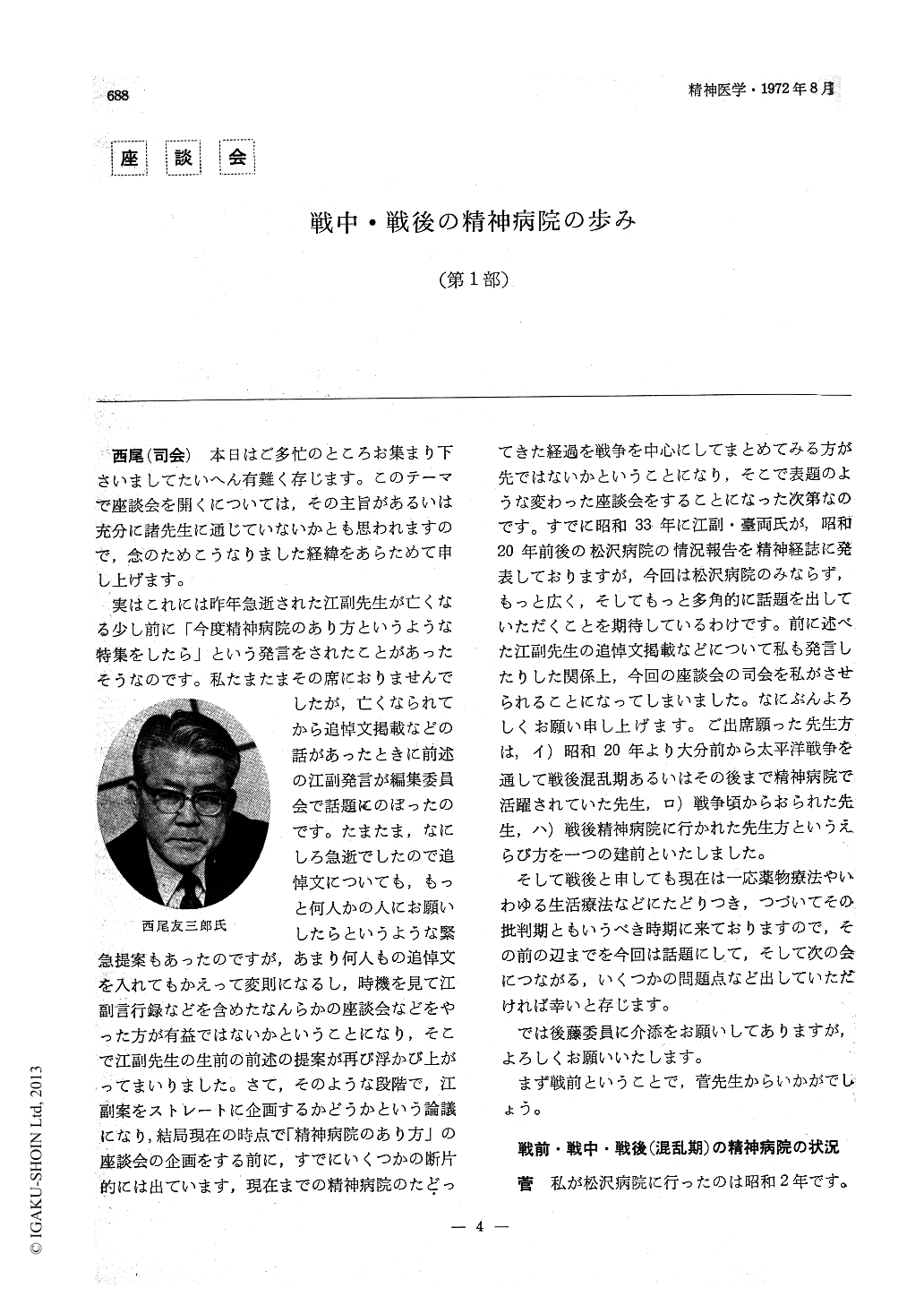6 0 0 0 戦中・戦後の精神病院の歩み—第1部
西尾(司会) 本日はご多忙のところお集まり下さいましてたいへん有難く存じます。このテーマで座談会を開くについては,その主旨があるいは充分に諸先生に通じていないかとも思われますので,念のためこうなりました経緯をあらためて申し上げます。 実はこれには昨年急逝された江副先生が亡くなる少し前に「今度精神病院のあり方というような特集をしたら」という発言をされたことがあったそうなのです。私たまたまその席におりませんでしたが,亡くなられてから追悼文掲載などの話があったときに前述の江副発言が編集委員会で話題にのぼったのです。たまたま,なにしろ急逝でしたので追悼文についても,もっと何人かの人にお願いしたらというような緊急提案もあったのですが,あまり何人もの追悼文を入れてもかえって変則になるし,時機を見て江副言行録などを含めたなんらかの座談会などをやった方が有益ではないかということになり,そこで江副先生の生前の前述の提案が再び浮かび上がってまいりました。さて,そのような段階で,江副案をストレートに企画するかどうかという論議になり,結局現在の時点で「精神病院のあり方」の座談会の企画をする前に,すでにいくつかの断片的には出ています,現在までの精神病院のたどってきた経過を戦争を中心にしてまとめてみる方が先ではないかということになり,そこで表題のような変わった座談会をすることになった次第なのです。すでに昭和33年に江副・臺両氏が,昭和20年前後の松沢病院の情況報告を精神経誌に発表しておりますが,今回は松沢病院のみならず,もっと広く,そしてもっと多角的に話題を出していただくことを期待しているわけです。前に述べた江副先生の追悼文掲載などについて私も発言したりした関係上,今回の座談会の司会を私がさせられることになってしまいました。なにぶんよろしくお願い申し上げます。ご出席願った先生方は,イ)昭和20年より大分前から太平洋戦争を通して戦後混乱期あるいはその後まで精神病院で活躍されていた先生,ロ)戦争頃からおられた先生,ハ)戦後精神病院に行かれた先生方というえらび方を一つの建前といたしました。
1 0 0 0 OA 京都府下元マンガン鉱採掘等作業従事者にみられたマンガン中毒の実態
- 著者
- 佐野 晴洋 山下 節義 川西 正祐 井口 弘 吉永 侃夫 小城 勝相 塚本 幾代 藤田 博美 岡本 浩子 加藤 伸勝 宮本 宣博 浮田 義一郎 山根 秀夫 森 律 池田 栄三 乾 修然 藤岡 惇 阿部 醇吉
- 出版者
- 日本衛生学会
- 雑誌
- 日本衛生学雑誌 (ISSN:00215082)
- 巻号頁・発行日
- vol.37, no.2, pp.566-579, 1982-06-30 (Released:2009-02-17)
- 参考文献数
- 32
- 被引用文献数
- 1 3
An epidemiological survey and clinical investigations were carried out on 162 retired workers from manganese mines and ore grinders, who were the residents of the Tamba district of Kyoto Prefecture. Most of the workers had been employed in small industrial factories with less than five employees under very poor working conditions. Fifty-five percent of them had worked in the mines and factories for longer than 11 years. Forty-six percent had been retired for 11-20 years, whereas 27% for longer than 21 years. A group of 124 people living in the same region but who had not been exposed to manganese served as the control group.The incidence of subjective symptoms associated with chronic manganese poisoning such as emotional instability, psychomotor irritability and neurologic abnormalities was apparently high in the experimental group and it increased with the period of exposure to manganese dust. Twenty-eight percent of the workers reported the subjective symptoms while they were employed, but 45% of them reported as late as six years after they retired.Of the retired workers, five (3.1%) had parkinsonism, three (1.9%) showed symptoms of hemiparkinsonism, and fifteen (9.3%) showed neurological symptoms including maskedlike, gait unbalance, slurred speech and imparied fine movements. Forty-five percent of these patients recognized these abnormalities for more than five years after they had left the contaminated workings. It is noteworthy that 39% of the retired workers were diagnosed as having pneumoconiosis.Some of the problems encountered in diagnosing manganese poisoning after exposure has been terminated is also discussed here.
- 著者
- 葉賀 弘 谷 直介 加藤 伸勝 鍋倉 正信 坂井 誠 小林 豊生
- 出版者
- 一般社団法人日本心身医学会
- 雑誌
- 心身医学 (ISSN:03850307)
- 巻号頁・発行日
- vol.21, no.1, 1981-02-01
